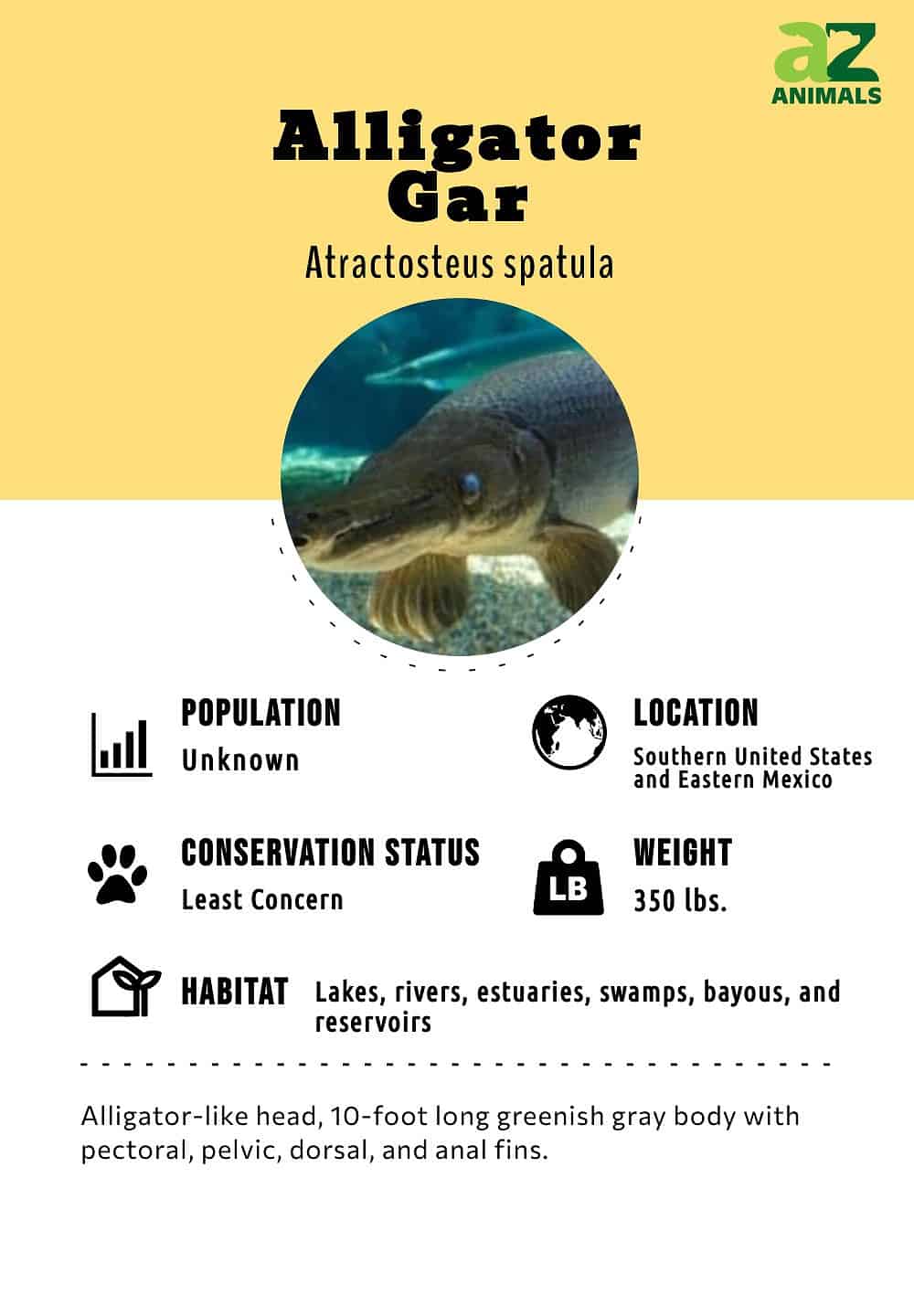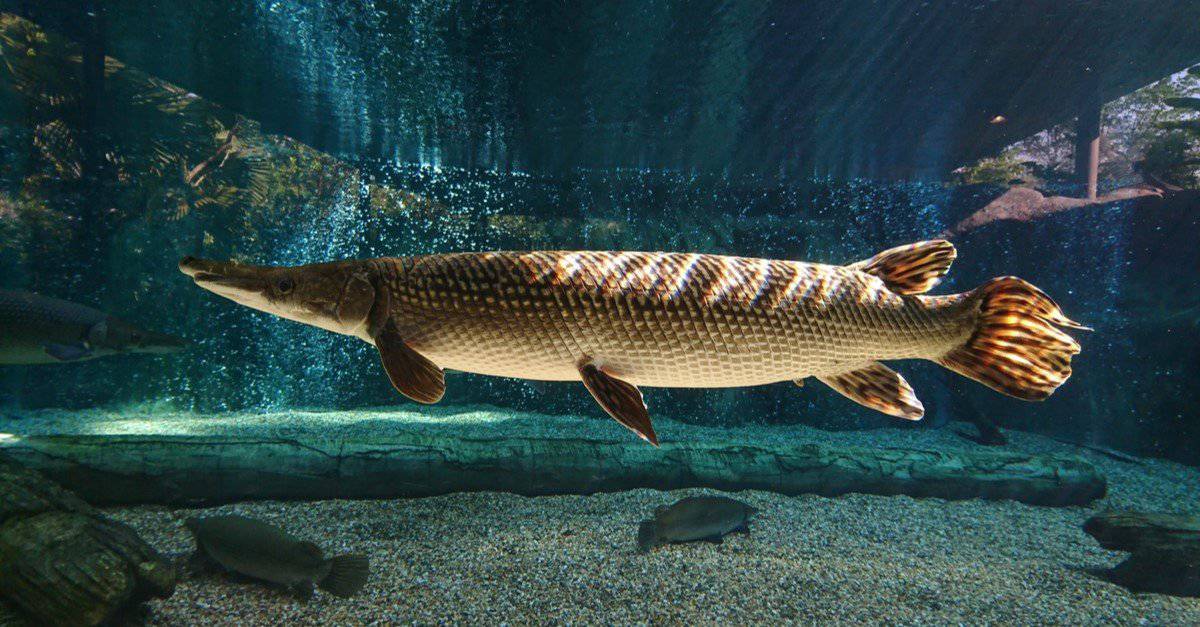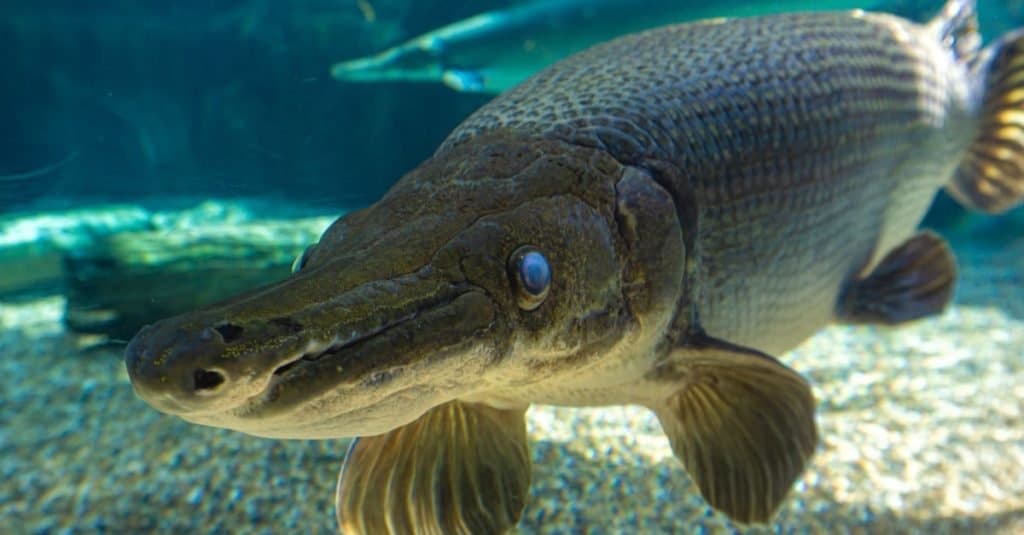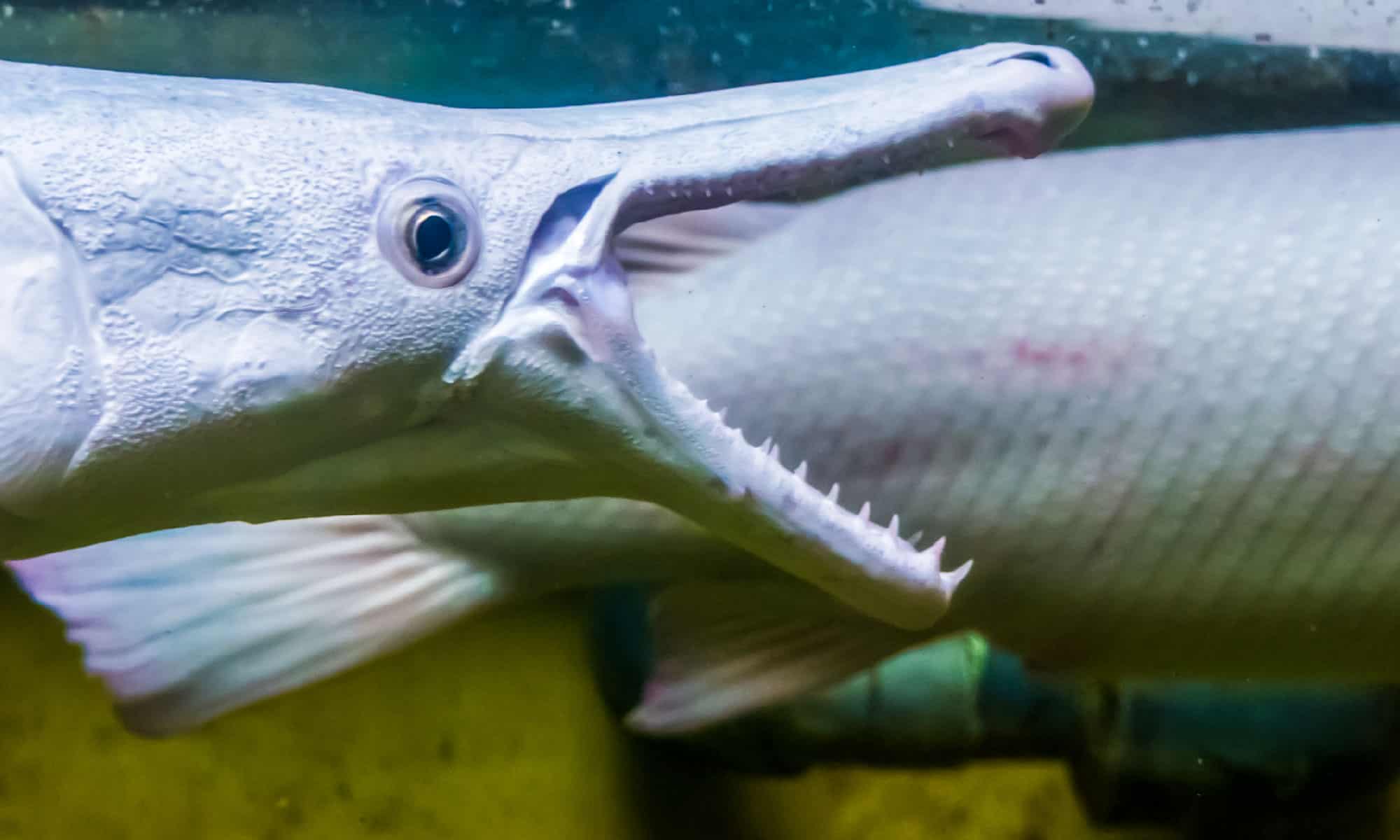Alligator Gar
Atractosteus spatula
The alligator gar has toxic eggs to protect against predators
Advertisement
Alligator Gar Scientific Classification
- Kingdom
- Animalia
- Phylum
- Chordata
- Class
- Actinopterygii
- Order
- Lepisosteiformes
- Family
- Lepisosteidae
- Genus
- Atractosteus
- Scientific Name
- Atractosteus spatula
Read our Complete Guide to Classification of Animals.
Alligator Gar Conservation Status
Alligator Gar Facts
- Main Prey
- Fish, turtles, birds, and mammals
- Group Behavior
- Solitary
- Fun Fact
- The alligator gar has toxic eggs to protect against predators
- Estimated Population Size
- Unknown
- Biggest Threat
- Overhunting
- Most Distinctive Feature
- Sharp teeth
- Other Name(s)
- Garpike
- Gestation Period
- 6-8 days
- Habitat
- Rivers, lakes, swamps, bayous, and estuaries
- Predators
- Humans and alligators
- Diet
- Carnivore
- Type
- Ray-finned fish
- Common Name
- Alligator Gar
- Number Of Species
- 1
View all of the Alligator Gar images!
The giant alligator gar is among the biggest freshwater fish in the world, but don’t let the large teeth and fearsome appearance fool you. It poses no particular risk of attack to humans.

Unfortunately, this species has earned an unfavorable reputation in its native habitat as a trash fish. On the mistaken belief that it damages nets and eats game fish, people hunted this species mercilessly in the 20th century. Once this misconception was finally corrected, the number of alligator gar increased quickly.
4 Incredible Facts!
- The evolution of the gar as a group dates back more than 100 million years in the fossil record. Modern gars still retain many “ancient” characteristics, including the ability to breathe both air and water and a spiral valve intestine like that of the shark.
- The name “gar” is based on an Anglo-Saxon term that means spike or lance. (Anglo-Saxon was the language spoken before the development of modern English)
- The gar’s body is heavily armored with scales.
- Some Native Americans used to make arrowheads and axes from the scales and head of the alligator gar.
- The largest alligator gar ever caught weighed in at 327 pounds! It was captured in Mississippi. Exceptionally large alligator gars are most common in Texas as well.
Classification and Scientific Name

All seven species of gar are located in North and Central America.
©Cheng Wei/Shutterstock.com
The scientific name of the giant alligator gar is Atractosteus spatula. The name spatula comes to us from a Latin word that roughly translates to “a flat piece.” The alligator gar is closely related to two other gar species within the genus of Atractosteus: the Cuban gar and the tropical gar. There are four other species of gar that occupy the closely related genus of Lepisosteus. Together these seven species represent all extant types of gar within the family of Lepisosteidae, and all are located in North and Central America:
- Alligator, Atractosteus spatula
- Cuban, Atractosteus tristoechus
- Florida, Lepisosteus platyrhincus
- Longnose, Lepisosteus osseus
- Shortnose, Lepisosteus platostomus
- Spotted, Lepisosteus oculatus
- Tropical. Atractosteus tropicus
Alligator Gar vs. Longnose Gar
Some people get these two species confused. The main difference is that the longnose gar has a smaller body (about 6.5 feet long) but a larger snout in relation to body size. It also has a much wider distribution across most of the eastern United States.
Appearance
The alligator gar is the giant heavyweight fish of its native environment. Measuring up to 10 feet and 350 pounds, it is the largest of all the gar species and one of the biggest freshwater fishes anywhere in North America. The world record for a catch was set at 327 pounds in 2011. This record fish was found at Mississippi’s Lake Chotard.

The snout of the alligator gar looks like that of an alligator, thus the name, although they are not related.
©TKBackyard/Shutterstock.com
The name of this species is obviously based on its physical similarities to the alligator. Like its namesake, the alligator gar has a very long body and snout, and a row of sharp teeth. But unlike the gator, the gar has fins to help it swim underwater. The two pectoral fins are located right by the head, the pelvic fins are located halfway down the body, and the dorsal and anal fins are located right next to the tail. Except for some rare variants, most alligator gar tends to come in similar colors. Gray, green, and brown colors with dark spots dominate around the back. These colors then fade to yellow or white around the lower stomach.
Distribution, Population, and Habitat
The alligator gar can be found in the lakes, rivers, estuaries, swamps, bayous, and reservoirs of the Southern United States and Eastern Mexico. Its range once extended as far north as Iowa and Nebraska, but after years of hunting, the alligator gar now mostly occupies the lower Mississippi River Valley and possibly as far south as Veracruz, Mexico. The gar’s bladder functions as a kind of lung that enables it to survive in water with low oxygen content. It also has the ability to tolerate a bit of salt water, but it never ventures out to the open sea.
The alligator gar is considered to be a species of least concern by the IUCN Red List. Common threats include pollution, habitat changes, and overhunting. The alligator gar was once hunted on a large scale for no other reason than the mistaken belief that it killed game fish and damaged fishing nets. As hunting has ceased, numbers have recovered a bit, but it has yet to fill all of its previous habitats.

The alligator gar preys upon fish, turtles, birds, and small mammals using its sharp teeth to advantage.
©Charlotte Bleijenberg/Shutterstock.com
Predators and Prey
The alligator gar is one of the top predators in its natural freshwater environment. It is an ambush predator that lies in wait for prey and then attacks with its large jaws. The gar’s good vision and ability to sense chemicals seem to be the main means by which they detect prey in the water. They play a similar role as sharks in marine ecosystems by keeping prey populations within healthy numbers.
What does the alligator gar eat?
The alligator gar preys upon almost anything that will fit into its mouth, including smaller fish, turtles, birds, and even small mammals. Some of their favorite fish include buffalo fish, carp, and shad.
For a complete analysis of what alligator gar eat, make sure to check out our guide ‘What Do Alligator Gar Eat‘ that lists 10 of their favorite prey.
What eats the alligator gar?
A fully grown alligator gar has few predators in the wild except for humans and actual alligators. The juveniles are sometimes preyed upon by other fish as well.
Reproduction and Lifespan

It take about 10 years of a 50-year life for an alligator gar to reach sexual maturity.
©tristan tan/Shutterstock.com
Scientists have yet to study the alligator gar’s reproductive behavior and development in great depth. From the little we do understand, we can say that the breeding season occurs between May and July. In Texas, at least, the female does not reproduce every year. Instead, she tends to reproduce when water overruns the banks and creates floodplains. This allows her to lay thousands of dark green or red eggs on the rocks and vegetation near the banks. Although they receive minimal parental care, the unborn gars have a very useful defense mechanism: their eggs are toxic to ingest.
After about six to eight days, the offspring hatch from the eggs, measuring only a small fraction of their full adult size. With their long, sinewy body, they almost resemble sticks. A disc on the snout lets them remain attached to rocks and vegetation, where they continue to grow rapidly by absorbing what’s left of the yolk sac. After the yolk is depleted, they must be ready to fend for themselves.
Since a typical lake can support only a few hundred alligator gar at most, many of the young are obviously expected to be lost to predation early on. This fish grows rapidly in its first year or two of life, though it takes about 10 years for the alligator gar to reach sexual maturity. Some have a lifespan of more than 50 years in the wild. Females seem to live longer than males on average.
Fishing and Cooking
This fish is a very niche type of fish that only the most dedicated recreational fishers would try to catch. For those fishers who are up to the challenge, it represents a real test of preparation and ability. Based on a survey by the Texas Parks and Wildlife Department, about 70% of respondents used a typical rod and reel as their primary means of catching the alligator gar. Most of the rest used the bow and arrow. Fishers also use passive gear such as juglines, limblines, and trotlines.
These fish have a white, firm flesh with a mild taste that resembles the flesh of many other sport fishes. Common methods of cooking include fried and barbecue alligator gar. Under no circumstances, however, should the toxic eggs ever be eaten. They may cause temporary sickness.
View all 194 animals that start with AAlligator Gar FAQs (Frequently Asked Questions)
How do you catch an alligator gar?
The alligator gar should only be pursued by experienced fishers. According to the Texas Park and Wildlife Department, “The most common setup used in Texas is cut common carp placed on a 5/0 or bigger circle hook, treble hook or J-hook with a gap wide enough to encircle the lower jaw. The hook is often fastened by strong braided line to a steel leader, with or without a weight, and fished suspended or on the bottom of a river or lake.” Fishers should give the gar some time to swallow the bait before attempting to reel it in since it is otherwise very resistant to hooks.
What does alligator gar eat?
The alligator gar preys upon fish, turtles, birds, and small mammals.
Are alligator gars dangerous?
Despite its ferocious appearance, the alligator gar has not been known to attack a human. However, fishers need to be wary. When it’s thrashing about on a hook, the sharp teeth can easily cut through the skin.
Can you eat alligator gar?
It is safe to eat both the juvenile and adult alligator gar, but the eggs are toxic and should never be eaten.
What are the differences between longnose gars and alligator gars?
The key differences between a longnose gar and an alligator gar are size, snout, teeth, diet, and taxonomy. The longnose gar is not only a different species from the alligator gar, but it is also in a different genus – although both are still in the gar family. Found in a wider range of habitats across the midwest and the eastern United States, the longnose gar is half the size of the alligator gar in both size and weight. In fact, in terms of size, the longnose gar can be as much as a third of the alligator gar’s length.
What was the largest alligator gar caught in Florida?
The largest alligator gar ever caught in Florida weighed 132 pounds!
What are the differences between Florida gar and alligator gar?
The greatest differences between a Florida gar and an alligator gar lie in their size and range. The alligator gar is a large fish, weighing between 100 and 350 pounds and measuring between 6 and 10 feet long. The Florida gar is a smaller fish weighing between 3 and 10 pounds while measuring about 1.8 to 4.4 feet in length.
Thank you for reading! Have some feedback for us? Contact the AZ Animals editorial team.
Sources
- Animal Diversity Web, Available here: https://animaldiversity.org/accounts/Atractosteus_spatula/
- National Geographic, Available here: https://www.nationalgeographic.com/animals/fish/a/alligator-gar/
- Texas Parks & Wildlife, Available here: https://tpwd.texas.gov/fishboat/fish/management/alligator-gar/

















